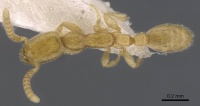Leptanilla tanakai
| Leptanilla tanakai | |
|---|---|

| |
| Scientific classification | |
| Kingdom: | Animalia |
| Phylum: | Arthropoda |
| Class: | Insecta |
| Order: | Hymenoptera |
| Family: | Formicidae |
| Subfamily: | Leptanillinae |
| Tribe: | Leptanillini |
| Genus: | Leptanilla |
| Species: | L. tanakai |
| Binomial name | |
| Leptanilla tanakai Baroni Urbani, 1977 | |
| Common Name | |
|---|---|
| Yakushima-mukashi-ari | |
| Language: | Japanese |
Known only from the type locality (Japanese Ant Image Database).
Identification
Keys including this Species
Distribution
Latitudinal Distribution Pattern
Latitudinal Range: 30.359° to 30.359°.
| North Temperate |
North Subtropical |
Tropical | South Subtropical |
South Temperate |
- Source: AntMaps
Distribution based on Regional Taxon Lists
Palaearctic Region: Japan (type locality).
Distribution based on AntMaps
Distribution based on AntWeb specimens
Check data from AntWeb
Countries Occupied
| Number of countries occupied by this species based on AntWiki Regional Taxon Lists. In general, fewer countries occupied indicates a narrower range, while more countries indicates a more widespread species. |

|
Estimated Abundance
| Relative abundance based on number of AntMaps records per species (this species within the purple bar). Fewer records (to the left) indicates a less abundant/encountered species while more records (to the right) indicates more abundant/encountered species. |

|
Biology
Castes
Nomenclature
The following information is derived from Barry Bolton's Online Catalogue of the Ants of the World.
- tanakai. Leptanilla tanakai Baroni Urbani, 1977c: 458, figs. 11, 33 (w.) JAPAN.
Description
References
- Baroni Urbani, C. 1977c. Materiali per una revisione della sottofamiglia Leptanillinae Emery (Hymenoptera: Formicidae). Entomol. Basil. 2: 427-488 (page 458, figs. 11, 33 worker described)
- Bolton, B. 1995b. A new general catalogue of the ants of the world. Cambridge, Mass.: Harvard University Press, 504 pp. (page 229, catalogue)
- Griebenow, Z. 2024. Systematic revision of the ant subfamily Leptanillinae (Hymenoptera, Formicidae). ZooKeys 1189, 83–184 (doi:10.3897/zookeys.1189.107506).
- Griebenow, Z.H., Isaia, M., Moradmand, M. 2022. A remarkable troglomorphic ant, Yavnella laventa sp. nov. (Hymenoptera: Formicidae: Leptanillinae), identified as the first known worker of Yavnella Kugler by phylogenomic inference. Invertebrate Systematics 36(12), 1118-1138 (doi:10.1071/is22035).
- Hosoishi, S., Kanao, T., Ogata, K. 2014. Rediscovery and DNA sequencing of Leptanilla tanakai Baroni Urbani (Hymenoptera: Formicidae) from Yakushima Island, Japan. Japanese Journal of Systematic Entomology, 20 (1): 25–26.
- Qian, Y.-H., Zheng-Hui, X., Man, P., Liu, G.-L. 2024. Three new species of the ant genus Leptanilla (Hymenoptera: Formicidae) from China, with a key to the world species. Myrmecological News 34: 21-44 (doi:10.25849/MYRMECOL.NEWS_034:021).
- Saroj, S., Mandi, A., Dubey, A.K. 2022. A new species of the rare ant genus, Leptanilla Emery (Hymenoptera: Formicidae) from Eastern Himalaya, India. Asian Myrmecology 15, e015005 (doi:10.20362/am.015005).
References based on Global Ant Biodiversity Informatics
- Baroni Urbani C. 1977. Katalog der Typen von Formicidae (Hymenoptera) der Sammlung des Naturhistorischen Museums Basel (2. Teil). Mitt. Entomol. Ges. Basel (n.s.) 27: 61-102.
- Baroni Urbani C. 1977. Materiali per una revisione della sottofamiglia Leptanillinae Emery (Hymenoptera: Formicidae). Entomologica Basiliensia 2: 427-488.
- Choi B.M., K. Ogata, and M. Terayama. 1993. Comparative studies of ant faunas of Korea and Japan. 1. Faunal comparison among islands of Southern Korean and northern Kyushu, Japan. Bull. Biogeogr. Soc. Japan 48(1): 37-49.
- Hosoishi S., M. Yoshimura, Y. Kuboki, and K. Ogata. 2007. Ants from Yakushima Island , Kagoshima Prefecture. Ari 30: 47-54.
- Terayama M. 1992. Structure of ant communities in East Asia. A. Regional differences and species richness. Bulletin of the Bio-geographical Society of Japan 47: 1-31.
- Terayama M., S. Kubota, and K. Eguchi. 2014. Encyclopedia of Japanese ants. Asakura Shoten: Tokyo, 278 pp.
- Yamane S., S. Ikudome, and M. Terayama. 1999. Identification guide to the Aculeata of the Nansei Islands, Japan. Sapporo: Hokkaido University Press, xii + 831 pp. pp, 138-317.
- Yamane S., Y. Harada, and K. Eguchi. 2013. Classification and ecology of ants. Natural history of ants in Southern Kyushu. 200 pages
- Yamane S.; Ikudome, S.; Terayama, M. 1999. Identification guide to the Aculeata of the Nansei Islands, Japan. Sapporo: Hokkaido University Press, xii + 831 pp. pp138-317.


